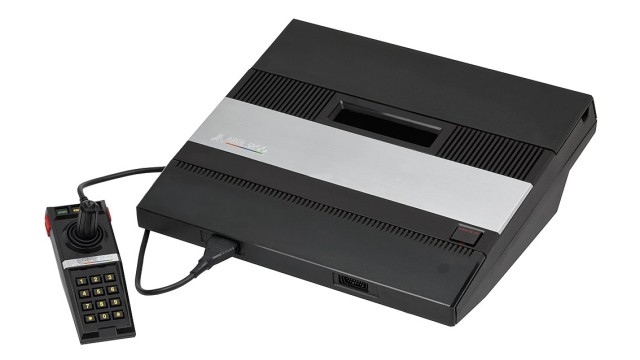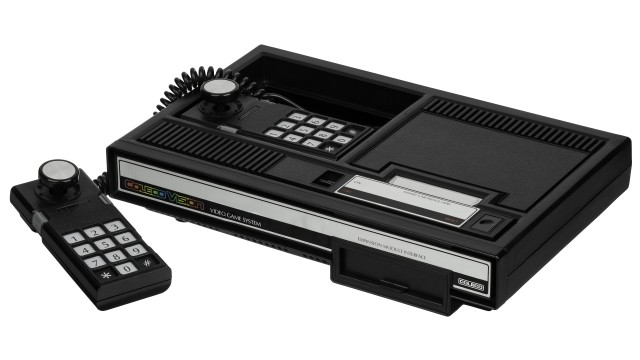
Atari 5200
Launches: 1982
Discontinued: 1984
Life span: 2 years
Units sold: 1 000 000
Generation: 2nd
 Atari 5200 technical specifications
Atari 5200 technical specifications
CPU: MOS 6502C @ 1,79 MHz
Memory: 16 KB
 Atari 5200 video specifications
Atari 5200 video specifications
Atari 5200 graphics capabilities.
Video chip: ANTIC & GTIA
Video connection:
 Atari 5200 audio specifications
Atari 5200 audio specifications
Atari 5200 sound capabilities.
Audio chip:
Audio mode:
 Controllers of Atari 5200
Controllers of Atari 5200
 Atari 5200 games support
Atari 5200 games support
Support: Cartridge
Atari 5200 games
Games library:
Atari 5200 story
The Atari 5200 was Atari's attempt to build on the success of its previous console, the Atari 2600, and to further dominate the home video game market during the early 1980s. The creation, development, launch, and subsequent market reception of the Atari 5200 provide a comprehensive view of the challenges and missteps that Atari faced during this crucial period in gaming history.
The creation of the Atari 5200 was rooted in the desire to offer a more advanced gaming experience than what was possible on the Atari 2600. By the early 1980s, the 2600 was showing its age, especially in terms of graphics and processing power, despite its commercial success and extensive library of games. The video game market was becoming increasingly competitive, with newer consoles like the Intellivision from Mattel and the ColecoVision from Coleco offering superior graphics and sound capabilities. Atari needed a more powerful system to stay relevant and continue to appeal to gamers who were beginning to expect more sophisticated gaming experiences.
The development of the Atari 5200 began as early as 1978, originally under the codename "Atari Video System X" (AVSX). Initially, the system was conceived as an entirely new console with a custom chipset designed to outperform competitors. However, as development progressed, Atari shifted its strategy due to cost considerations and the desire to bring the system to market more quickly. Instead of creating an entirely new console from scratch, Atari decided to base the 5200 on its existing Atari 400/800 computer technology. This decision allowed Atari to leverage the powerful hardware and graphics capabilities of its home computers, which were already well-regarded for their advanced features. The 5200 was essentially a repurposed Atari 400/800, stripped of its keyboard and other computer-specific components, to focus purely on gaming.
The Atari 5200 featured the ANTIC and GTIA chips from the 400/800 computers, which provided the system with impressive graphical capabilities for the time. It could display more colors on-screen, had smoother scrolling, and supported more complex sprites compared to the 2600. The system also featured a 6502 CPU, which was more powerful than the processor used in the 2600, allowing for more sophisticated game designs. Despite these advancements, the decision to base the 5200 on existing technology led to certain compromises, including compatibility issues that would later impact its market performance.
The controllers developed for the Atari 5200 were intended to be one of the system’s standout features, offering an analog joystick with a keypad, start, pause, and reset buttons directly on the controller itself. This was a significant upgrade from the simpler controllers of the 2600 and was designed to give players more control and options during gameplay. However, the controllers quickly became one of the system's most criticized aspects. They were prone to malfunctions, particularly with the analog joystick, which was not self-centering and often became unresponsive. This issue with the controllers became a significant point of frustration for many users and contributed to the 5200's negative reception.
The launch of the Atari 5200 took place in late 1982, a crucial time in the video game industry. The market was becoming increasingly saturated, and consumer expectations were high. Atari aimed to position the 5200 as a premium product, one that would appeal to both existing Atari 2600 users looking to upgrade and new customers attracted by the promise of advanced gaming experiences. The initial marketing campaign emphasized the 5200’s superior graphics, sound, and game library, positioning it as the most powerful gaming console on the market.
However, the launch of the Atari 5200 was plagued by several issues that hindered its success. One of the most significant problems was the lack of backward compatibility with Atari 2600 games. Despite being based on the same core technology as the 2600, the 5200 was not designed to play the older system's games, a decision that alienated a large portion of Atari's existing customer base. This was a critical misstep, especially considering that many gamers had already invested heavily in their 2600 game libraries. Atari eventually released a compatibility adapter that allowed 2600 games to be played on the 5200, but by then, much of the damage had already been done.
Another issue at launch was the limited library of games available for the 5200. While some titles, like Super Breakout and Space Invaders, were well-received, the initial lineup did not offer enough exclusive or innovative content to justify the upgrade from the 2600. Additionally, many of the games available on the 5200 were ports of existing Atari 400/800 computer games, which led to criticism that the system was not offering enough new or original experiences. This perception was compounded by the fact that the 5200 did not initially have as many third-party developers creating content for it as its competitors did, further limiting its appeal.
The market reception of the Atari 5200 was mixed at best. While some consumers were impressed by its advanced graphics and sound capabilities, many were disappointed by its incompatibility with 2600 games, the problematic controllers, and the limited game library. The system did not perform as well as Atari had hoped in the marketplace, especially compared to its predecessor, the Atari 2600, which continued to sell well even as the 5200 struggled to gain traction.
Compounding these challenges, the broader video game market was entering a period of instability. The industry was becoming increasingly crowded with new consoles and games, many of which were of poor quality. This oversaturation, coupled with the missteps in the 5200’s design and launch, meant that the console was unable to establish itself as a market leader. By 1984, the video game industry was in the midst of a massive downturn, often referred to as the video game crash of 1983, which saw many companies go out of business and others, like Atari, suffer significant financial losses. The 5200 was discontinued in 1984, just two years after its launch, as Atari shifted its focus to other projects in an effort to recover from the crash.
In retrospect, the Atari 5200 is often seen as a cautionary tale in the history of video gaming. It was a console that had significant potential, with advanced hardware and ambitious design goals, but it was ultimately undone by a series of strategic miscalculations and market conditions. The decision to base the system on existing technology, while understandable from a cost perspective, led to compromises that limited its appeal. The problematic controllers, lack of backward compatibility, and insufficient game library all contributed to the system’s struggles in the marketplace. The Atari 5200’s failure also marked the beginning of a period of decline for Atari, which had once been the dominant force in the video game industry.
Previous Atari console: Atari 2600
Next Atari console: Atari 7800


